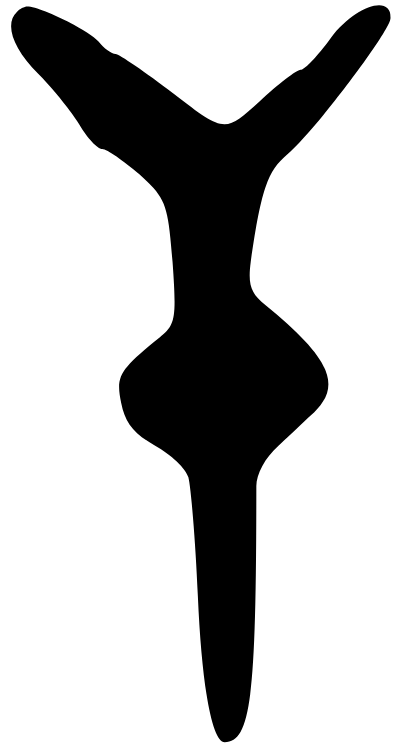51. The "Dry" Radical: 干
The three-stroke 干 shape serves as both the "dry" radical and this kanji:
干 (825: dry; to ebb; interfere; air out)
From this character the radical takes its English name "dry," as well as two of its Japanese names. That is, the Japanese refer to the radical as follows:
かん
いちじゅう
ほす
The first and third names reflect Joyo readings of 干—namely, the on-yomi カン and the kun-yomi ほ•す. As for いちじゅう, that corresponds to the numbers 一 (いち: one) and 十 (じゅう: ten), the idea being that 干 looks like 一 over 十. Thus, Nelson offers the radical nickname "one ten." I'll just stick with "dry."
Searching for 干 in Kanji
The 干 character originally looked different:

© Richard Sears
Bronze-script version.
This shape depicted a "forked weapon, possibly made from a tree branch" and maybe with a hand guard, says Henshall in his newer edition (the source of all etymological information in this Radical Note). He comments that this character may have come to mean "dry" after the Chinese borrowed it to stand in for the more complex 乾 (dry).
The 干 kanji features an on-duty 干 radical, as do these kanji:
年 (64: year)
幸 (279: happiness; good fortune)
平 (388: flat; ordinary; calm, peaceful)
幹 (637: trunk; main part; to do)
Be that as it may, I spot a clear 干 shape only in the last character. And etymologically our radical is nowhere to be found in this group. Check out Henshall's analyses of each:
年 (64: year)
Do you see 干? Do you see a man? The character may depict a "man carrying a load of grain plants on his back," indicating the "annual harvest and by extension the annual cycle in general," says Henshall. Or the character may symbolize a "man dancing while carrying grain on the occasion of a rite asking for a good harvest." Henshall cites a third researcher who sees one part of 年 as representing "grain" and the other part as 千 (thousand), a phonetic later replaced by the top two strokes of 年. Those two strokes represent "person."
幸 (279: happiness; good fortune)
The original shape combined 夭 with 逆. Through "distortion," says Henshall, the character evolved to look the way it now does. Thus, our 干 radical isn't in 幸 at all.
平 (388: flat; ordinary; calm, peaceful)
An early shape represented an “aquatic plant,” one that may have been floating and rootless. The top stroke was later added, probably to represent the flat surface of water. Henshall calls “flat, even” extended usage and “calm” a further extended sense. This character doesn’t contain 干.
幹 (637: trunk; main part; to do)
The original form included a 木. Later 干 took its place, functioning as the phonetic. So 干 is both the radical and the phonetic in 幹.
Photo Credit: Eve Kushner
At a now-shuttered restaurant called Hokusai in Beverly Hills (a ritzy part of the Los Angeles area), the (founding?) date 二千六年 (2006) appeared on an interior wall. Our radical is supposedly in 年, but 千 (thousand) looks much more likely to contain 干. Nope! The radical of 千 is 十 (radical 24: "cross"). I mentioned that 千 was once part of the 年 shape, so that's another reason to enjoy seeing 千 and 年 together in this way.
Photo Credit: Eve Kushner
At this teahouse in Nikko (in Tochigi Prefecture on Honshu), the wooden sign bears these kanji:
高津屋庄平
Well, the 高 appears in a variant form, but the other characters have their regular shapes. The last one is our 平 (388: flat; ordinary; calm, peaceful). As for 屋 and the non-Joyo 庄, both include a 土 component that stands as a counterpoint to our 干 shape. Of course, 土 is radical 32 ("earth").
One more treat: on the white square sign on the bottom left, I spot 干柿 (ほしがき: dried persimmons). There at last is 干! I've been looking for it everywhere!
